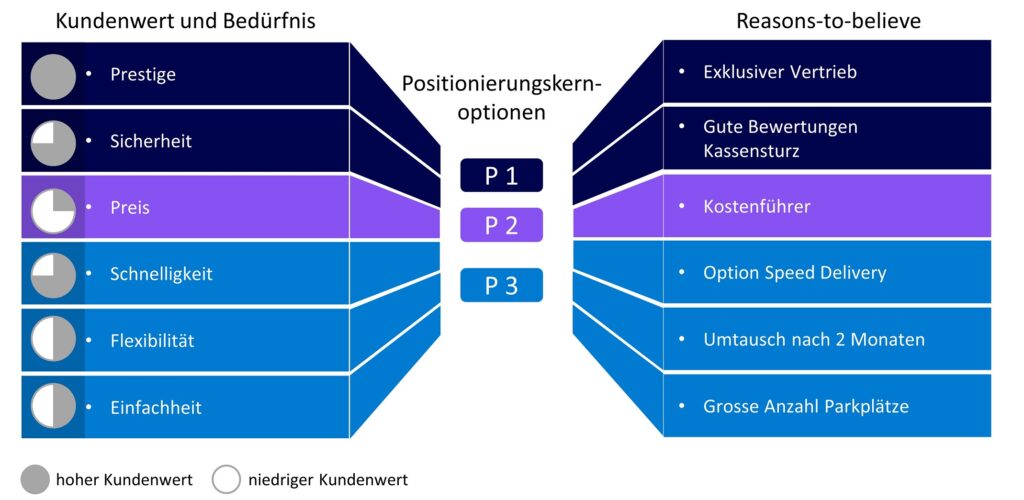Brand positioning, as a condensation of brand identity and as a link between brand identity and brand image, plays a very important role in brand management. A brand is worthless unless it has been positioned as uniquely as possible. Brand positioning is used to distinguish one’s own brand from competitor brands. The aim should be to focus on a small number of positioning dimensions.
Definition brand positioning
Brand positioning is the planning, implementation, control and further development of a position in the perception space of relevant target groups which is aligned to the ideal conceptions of the customers, differentiates from the competition and can be represented by the own competence equipment and conforms to the brand identity.

The positioning goes beyond the offer and should show how the brand is staged, celebrated and communicated. To put it more concretely, when a fast food chain opens a branch in the neighborhood, only the fry shop that has staged the sale of the fries in the past so that customers come for the staging and not just for the fries will survive. Brand positioning can be based on two different approaches:
- Reactive
- Active
Reactive brand positioning builds on articulated customer needs. Reactive brand positioning provides, among other things, the advantage that a comparison with the competition is possible. Based on mostly quantitative customer surveys, positioning can be performed using image profiles, discriminant analysis, repertory grid technique, multidimensional scaling (MDS) or conjoint analysis.
In general, reactive positioning has several shortcomings, although it is popular in
practice:
- Trend toward the equalization of competing offerings
- Reactive customer relationship management
- Lack of innovation orientation
- Insufficient assumptions about customer behavior
Reactive positioning violates one of the basic premises of customer value-based decision making or customer insights. When each organization has the same information, there is a tendency to make similar decisions, develop similar positioning, and become more and more aligned in results. This leads the actual goal of brand positioning ad absurdum. In addition, reactive positioning supports reactive customer relationship management because it is based on needs on the past. This goes hand in hand with a possible lack of innovation orientation. In addition to systematic elaboration and support by figures, differentiating positioning always requires a certain amount of creativity, speculation and, above all, foresight in the sense of trend analysis.
However, the central criticism of reactive brand positioning is that hardly any organization is allowed to have deficits in basic or hygiene features of a brand. This development has been observed since the 1990s and has intensified in recent years. As a result, the reactive positioning analysis can be used to understand the initial situation, but from the point of view of improving customer orientation, the focus should be on a combination with active positioning. Most organizations are market challengers. Thus, the question becomes, “Do we play by the existing rules or do we introduce new rules?” In line with the white space idea, active positioning can be used to establish new rules and attack supposedly stronger brands. At this point, the close connection between strategy and brand management becomes clear. The central reason why this is so rarely observed in practice is the high risk of active positioning. This builds on latent, future needs of customers. In doing so, those responsible face the challenge that the selected future needs must be relevant enough for the customer (purchase) and for the organization (customer value). This risk can be mitigated by combining trend analysis with, for example, a market analysis. Reduce repertory grid technique significantly.
Development of a brand positioning
The development of the positioning core includes four stages. Regardless of which
positioning type is chosen, the first step is to set out the customer’s needs and their value potential. From the point of view of customer orientation, existing brand management models need to be criticized here. So far, no model has explicitly presented the integration of customer value in the context of brand positioning. Brand positioning so far only addresses needs and differentiation, but consideration should also be given to whether the chosen positioning has sufficient value potential for the organization. For example, it can be very tempting to focus on security because it is the most relevant need for most customers in a category. However, it may be that this customer group buys very infrequently and spends significantly less than customer groups for whom convenience is more important. Existing brand management models therefore need to be supplemented by the customer value dimension as part of the positioning development
.
Subsequently, these needs are combined into several positioning core options. In a further step, each customer need is assigned areason-to-believe based on the target brand identity. A Reason-to-Believe is the understandable reason for customers to trust the chosen positioning. In the final step, the different positioning core options are to be evaluated with regard to their value for the customers and the organization (cf. the figure in this article). This can result in different outcomes. An attractive positioning option can only be supported to a limited extent by the existing brand identity. Then it is necessary to decide whether the brand identity should be adapted or a less attractive positioning should be chosen. It may also be that two positioning options are more or less equally attractive. In addition, there is a possibility that brand identity may support the most important need of most customers, but their customer value is significantly lower than customers for whom other needs are more relevant. Here, conflicts often arise in decision-making, which shows the high relevance of systematically gaining customer insights over time. The more customer insights available, the more likely positioning options can be successfully evaluated. One-off customer surveys to define a brand positioning should be rejected.
To complete the brand positioning, ensure that the entire organization internalizes the brand positioning and that employees align their actions with it. This shows the close connection between brand management and customer orientation. Employees’ attitudes and behavior must first be influenced before customer management or the brand can have an impact on customers. In addition to informing every employee in an organization in writing, I recommend that every department in the organization conduct workshops on the topic: “How can we strengthen the brand through our behavior?” The results are in turn made available to everyone in the organization and should be repeated regularly, especially in brand building or repositioning. This is the only way to ensure that the brand is actually lived in the organization.




